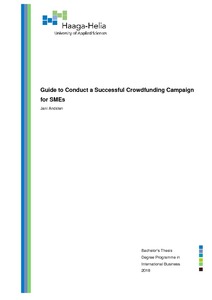Guide to Conduct a Successful Crowdfunding Campaign for SMEs
Andsten, Jani (2018)
Andsten, Jani
Haaga-Helia ammattikorkeakoulu
2018
All rights reserved
Julkaisun pysyvä osoite on
https://urn.fi/URN:NBN:fi:amk-201805249939
https://urn.fi/URN:NBN:fi:amk-201805249939
Tiivistelmä
This thesis follows a traditional research-based structure. The thesis focuses on reward-based crowdfunding and its applications for SMEs, as well as introduces a step-by-step guide to build a campaign. The thesis was commissioned by Trade Partners Finland Oy, the company behind a brand called Aarni Wood. The purpose of this thesis is to understand the crowdfunding scene better, as well as to learn how crowdfunding campaigns can be lever-aged.
The first part of the thesis focuses on introducing the concept of crowdfunding in general, its forms, and available platforms for reward-based crowdfunding. The research then looks into the Finnish market specifically, covering the size of the market and the legality of reward-based funding.
Both qualitative and quantitative research were conducted to analyze international crowd-funding. Interviews were used to collect personal experiences from Finnish crowdfunding creators to determine what generally works, and what should be taken into account when conducting a campaign. In addition to the interviews, raw Kickstarter campaign data was extracted from the platform to gain some quantitative data regarding watch campaigns on the platform. Other secondary data were collected from online sources and articles, and were used to support the primary data.
The research shows that crowdfunding can be leveraged in Finland to fund and market a new product or service. Crowdfunding is therefore considered a low-risk, medium-effort alternative to more traditional types of funding and marketing.
It was also found that crowdfunding platforms have taken social collaboration and crowdsourcing online, and with the help of Web 2.0 and social media platforms, geographical boundaries have been removed. Furthermore, online crowdfunding has enabled anyone to take part in funding a project, with even the smallest financial contribution.
As a result of the research, a step-to-step guide was added to help SMEs plan crowdfunding campaigns.
The first part of the thesis focuses on introducing the concept of crowdfunding in general, its forms, and available platforms for reward-based crowdfunding. The research then looks into the Finnish market specifically, covering the size of the market and the legality of reward-based funding.
Both qualitative and quantitative research were conducted to analyze international crowd-funding. Interviews were used to collect personal experiences from Finnish crowdfunding creators to determine what generally works, and what should be taken into account when conducting a campaign. In addition to the interviews, raw Kickstarter campaign data was extracted from the platform to gain some quantitative data regarding watch campaigns on the platform. Other secondary data were collected from online sources and articles, and were used to support the primary data.
The research shows that crowdfunding can be leveraged in Finland to fund and market a new product or service. Crowdfunding is therefore considered a low-risk, medium-effort alternative to more traditional types of funding and marketing.
It was also found that crowdfunding platforms have taken social collaboration and crowdsourcing online, and with the help of Web 2.0 and social media platforms, geographical boundaries have been removed. Furthermore, online crowdfunding has enabled anyone to take part in funding a project, with even the smallest financial contribution.
As a result of the research, a step-to-step guide was added to help SMEs plan crowdfunding campaigns.
